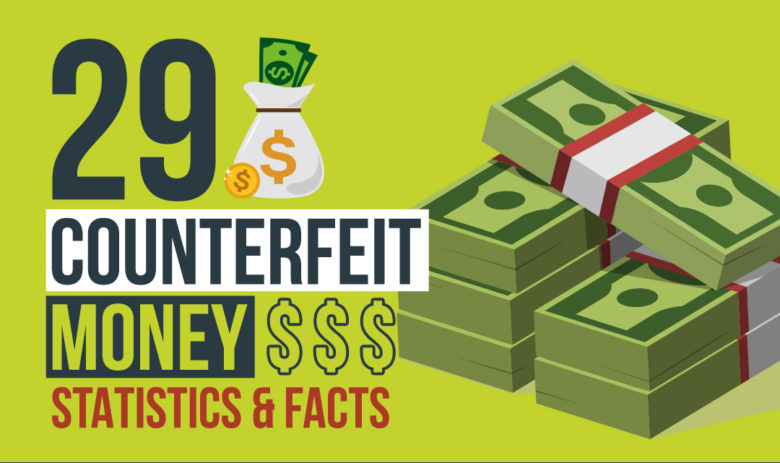Counterfeit money is a big problem in the United States.
According to statistics, 44 Billion dollars of counterfeit goods are imported each year.
Sure, this includes items like fake DVDs and makeup, but it also means an influx of counterfeit money coming into circulation.
This article will cover 29 alarming counterfeit money statistics with an infographic you’ll never see coming.
How Much Counterfeit Money Is In Circulation (2023)?
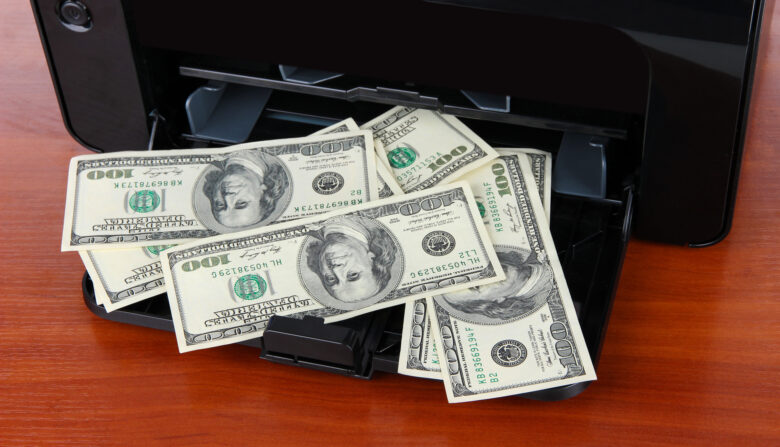
According to the United States Department of Treasury, counterfeit bills worth between $70 and $200 million are in circulation at any given time.
As of March 2021, approximately half of all dollars in circulation were held outside the country. (From the Federal Reserve Report)
There is approximately one counterfeit note for every 10,000 genuine currency notes. (USDT)
According to Reuters, the $20 bill is the most commonly counterfeited note.
Approximately 60% of all counterfeit money in circulation in the United States is a $20 bill.
The most common counterfeit money in the world is a $100 bill.
According to the US Secret Service, more than $147 million in counterfeit US currency is in circulation worldwide, with 60% of it circulating in the United States. (Image courtesy of CNBC)
Money forgery is common in the United States. In the United States, approximately $4,370,300 in counterfeit money was confiscated between January and February of 2021. Suppose it is possible to produce such massive amounts of counterfeit money in only two months. In that case, this crime will pose a significant threat to the US economy if the necessary safeguards were not implemented.
This type of criminal activity was common even in earlier years. The distribution of $43 million in counterfeit money to the general public in 1998, out of a total of $500 billion in circulation, demonstrates that counterfeiting money has become a popular criminal enterprise over the years. This means that for every $11600 in circulation, there was one dollar of counterfeit money.
In 2011, $70 million in counterfeit notes were discovered in circulation, indicating a similar pattern to 2010. To put it another way, on the low end, there was one counterfeit bill for every $10000 of real money in circulation.
Top 5 Counterfeit Money Statistics (Editor’s Choice)
- In the early 2000s, Bourassa made $250 million in counterfeit US currency, making him the largest money counterfeiter in US history.
- In the 1998 fiscal year, 45 percent of all counterfeit US currency circulated in the US was printed outside the country.
- A lithograph machine is used to produce 90% of counterfeit money in the United States.
- In 2014, the 20-dollar bill was the most counterfeited in the United States, while the 100-dollar bill was the most counterfeited internationally.
- The global market for detecting counterfeit money is expected to reach 1.5 billion USD by 2021, with a compound growth rate of 6.5 percent.
25 Counterfeit Money Statistics in the US
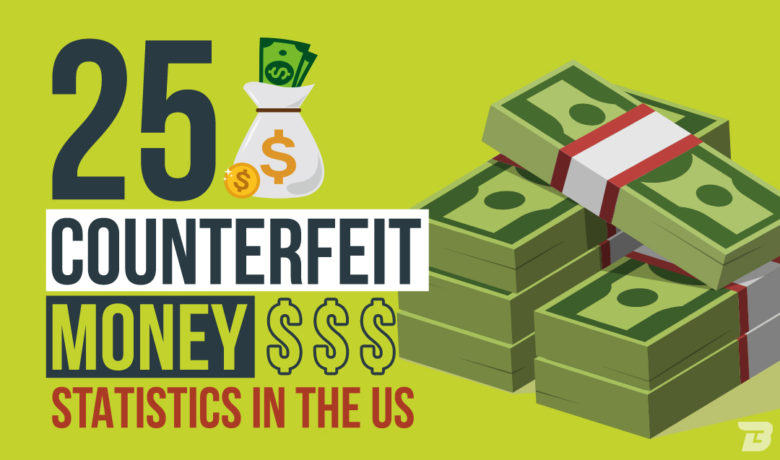
1) Only $17.1 million in counterfeit notes entered the US commercial mainstream in 1991, accounting for 25% of all counterfeit currency produced in America.
The United States Secret Service seized approximately 87 million USD in counterfeit banknotes before being released into circulation. When the remaining counterfeit money was discovered, the Federal Reserve System removed it from circulation.
(Source: The National Academies Press)
2) In the early 2000s, Bourassa made $250 million in counterfeit US currency, making him the largest money counterfeiter in US history.
Bourassa had a piece of paper in his possession that looked eerily similar to that used by the Bureau of Engraving and Printing in the United States. He made counterfeit twenty-dollar bills with security features identical to those found on genuine twenty-dollar bills in the United States. He operated his business from a printing shop on his property, where he sold counterfeit notes for approximately $50 million before being apprehended.
(Source: Wauchula State Bank)
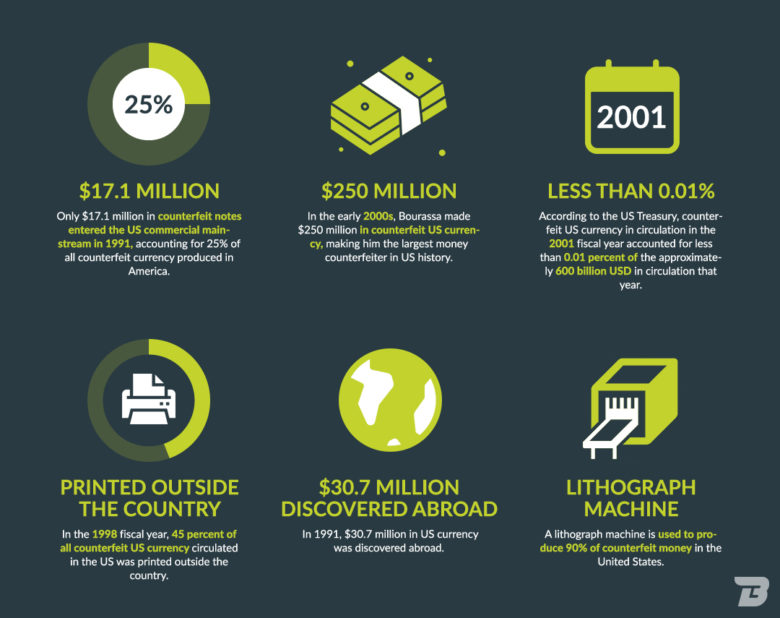
3) According to the US Treasury, counterfeit US currency in circulation in the 2001 fiscal year accounted for less than 0.01 percent of the approximately 600 billion USD in circulation that year.
The proportion of counterfeit money in circulation was almost non-existent in 2001. The efforts of the United States Secret Service were recognized this year. Prior to the establishment of the Federal Reserve in 1965, approximately one-third to one-half of the money in circulation in the United States was counterfeit.
The Secret Service of the United States and the Federal Reserve Bank of the United States collaborated to reduce the amount of counterfeit money in circulation.
(Source: frbsf)
4) In the 1998 fiscal year, 45 percent of all counterfeit US currency circulated in the US was printed outside the country.
As a result, counterfeit US currency has become a global problem, even though counterfeiting US currency is not considered a global crime in many countries. Worryingly, there is no central repository for counterfeit notes nor a standardized mechanism for reporting counterfeit activity.
(Source: The United States Treasury Department)
5) In 1991, $30.7 million in US currency was discovered abroad.
Because there is no global mechanism for reporting all instances of counterfeiting, the information provided here may be incomplete. As a result, counterfeiting of US currency in other countries may be a more serious problem than this figure suggests.
(Source: The National Academies Press)
6) A lithograph machine is used to produce 90% of counterfeit money in the United States.
Money counterfeiting using lithographic techniques necessitates professionalism and expertise, as well as specialized equipment and materials. Counterfeiters use this technique for economic reasons because it allows them to produce large quantities of counterfeit notes, making it easier for law enforcement agencies to track down the source and seize the counterfeit money.
(Source: The National Academies Press)
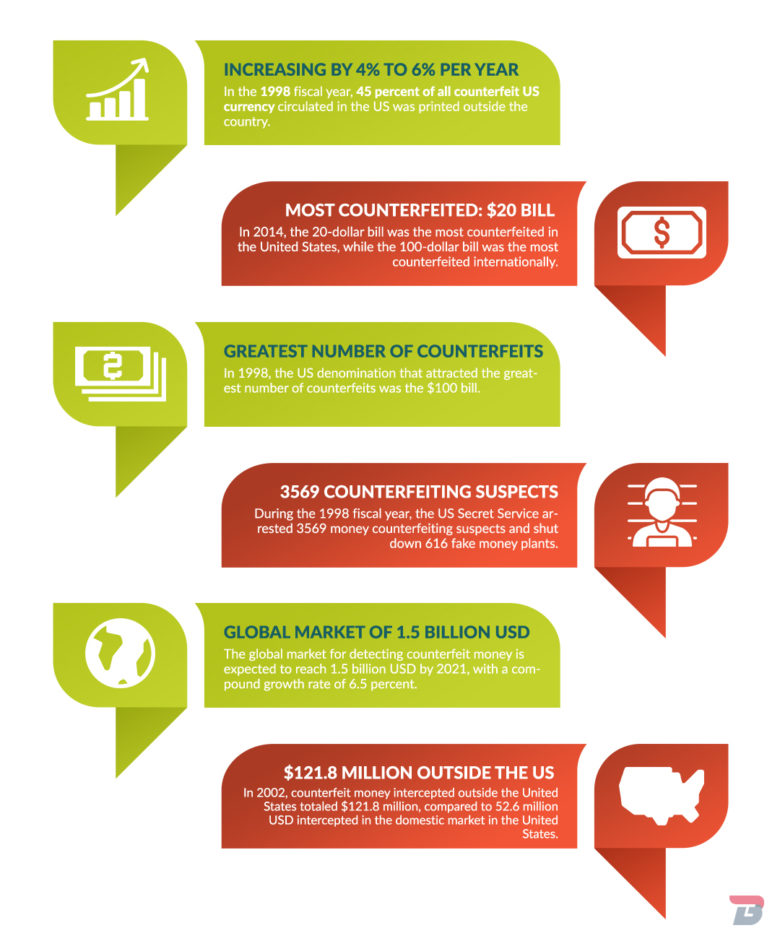
7) According to US Secret Service estimates from 1993, money counterfeiting was increasing by 4% to 6% per year.
According to the 1993 fiscal year, counterfeit US money worth $20 million entered the commercial mainstream in the United States during the data. During the same fiscal year, 121 million USD in counterfeit US currency was recovered worldwide during the manufacturing process before it entered circulation.
(Source: The National Academies Press)
8) In 2014, the 20-dollar bill was the most counterfeited in the United States, while the 100-dollar bill was the most counterfeited internationally.
During this period, counterfeit US currency totaling $147 million was in circulation worldwide. In the same year, 2191 people were arrested for using counterfeit money, and 188 counterfeit money manufacturing facilities were closed worldwide.
(Source: CNBC)
9) In 1998, the US denomination that attracted the greatest number of counterfeits was the $100 bill.
According to the FBI, the 100-dollar bill was the most frequently counterfeited denomination in percentage and monetary value. False $100 bills were worth nearly $6 million in 1998, accounting for 60% of all counterfeit bills processed that year.
Counterfeiters likely targeted this currency because it is the most commonly used denomination in circulation. According to the Federal Reserve, the Federal Reserve’s holdings of $100 notes increased from 21% in 1965 to 65% in 1998.
(Source: The United States Treasury Department)
10) During the 1998 fiscal year, the US Secret Service arrested 3569 money counterfeiting suspects and shut down 616 fake money plants.
The United States Secret Service is dedicated to eradicating counterfeiting. As a result of this commitment, the immediate consequences of counterfeiting in the United States are minor compared to check fraud’s consequences. In 1995, for example, the cost of check fraud was 615 million USD, nearly 20 times the cost of money counterfeiting in the same year.
(Source: The United States Treasury Department)
11) The global market for detecting counterfeit money is expected to reach 1.5 billion USD by 2021, with a compound growth rate of 6.5 percent.
According to the research, the Coin and Currency Counter market sector was found to have a growth potential of over 6 percent. It is expected that by 2025, this business will have generated more than 1.4 billion USD.
(Source: Research and Markets)
12) In 2002, counterfeit money intercepted outside the United States totaled $121.8 million, compared to 52.6 million USD intercepted in the domestic market in the United States.
In the same year, more counterfeit US currency was discovered outside of the country than in the country.
(Source: Made of Money)
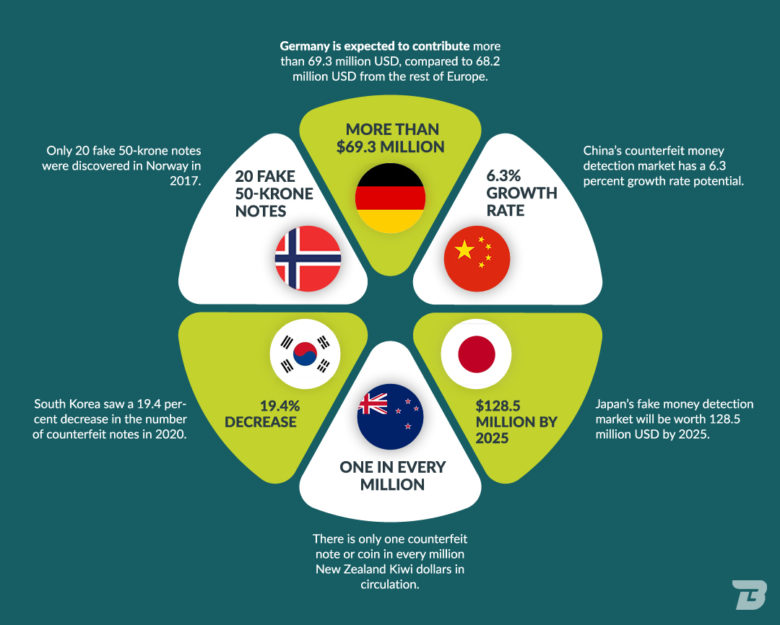
13) Germany is expected to contribute more than 69.3 million USD, compared to 68.2 million USD from the rest of Europe.
According to estimates, Germany’s fake money detection industry will provide more returns to the global economy than the rest of the European market combined by 2025. The United States is expected to maintain its current growth rate of 7.5 percent during this period.
(Source: Research and Markets)
14) China’s counterfeit money detection market has a 6.3 percent growth rate potential.
China has the world’s second-largest economy. It is expected that the vast majority of businesses will seize this opportunity and invest heavily in the fake money detection industry in the coming years.
As a result, China will contribute approximately 225.9 million USD to the global market. If this happens, China will most likely overtake the rest of the European Union as the world’s largest market for counterfeit money detection.
(Source: Research and Markets)
15) Japan’s fake money detection market will be worth 128.5 million USD by 2025.
Japan’s coin and currency counter market will be near twice the rest of Europe combined.
(Source: Research and Markets)
16) There is only one counterfeit note or coin in every million New Zealand Kiwi dollars in circulation.
The Reserve Bank of New Zealand admits that counterfeiting of their currency is much lower than counterfeiting of currency from other countries.
(Source: Love Money)
17) South Korea saw a 19.4 percent decrease in the number of counterfeit notes in 2020.
According to the Bank of Korea, forgeries began to decline in the first half of 2017. On the other hand, this country is home to some of the world’s most skilled counterfeiters, who specialize in producing more valuable currencies such as US dollars.
(Source: Love Money)
18) Only 20 fake 50-krone notes were discovered in Norway in 2017.
This made headlines because such an occurrence was extremely rare in that country.
(Source: Love Money)
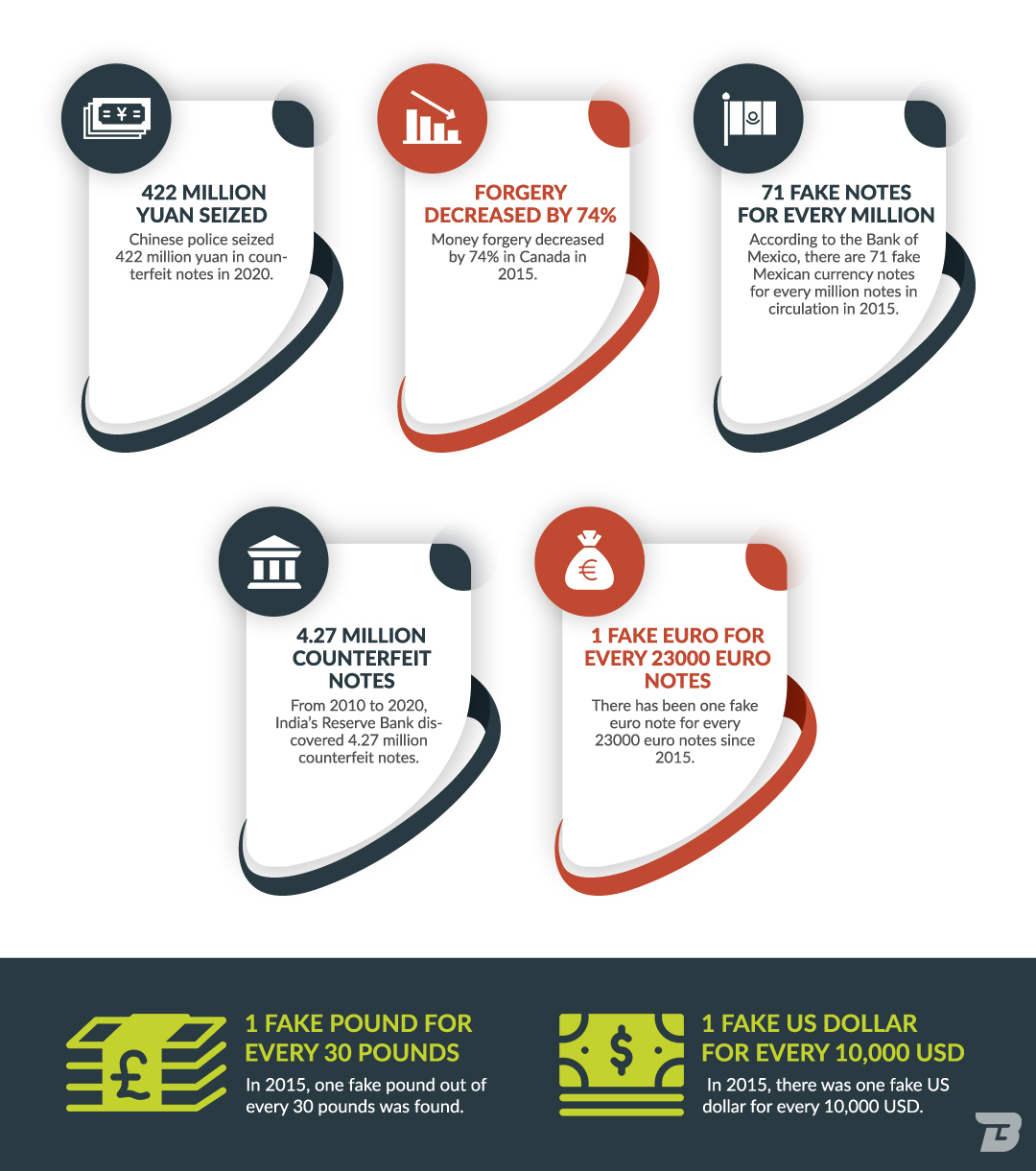
19) Chinese police seized 422 million yuan in counterfeit notes in 2020.
Despite China’s 100 yuan note being only introduced in 2015, it is the most frequently counterfeited denomination. Fake 100-yuan banknotes can be purchased for as little as 6 yuan.
(Source: Love Money)
20) Money forgery decreased by 74% in Canada in 2015.
Although counterfeiting has decreased, it was discovered that during the fiscal year 2015, there was one fake Canadian dollar for every 3600 real Canadian dollars in circulation. As a result, the Canadian dollar remains the sixth most counterfeited currency in the world.
(Source: Love Money)
21) According to the Bank of Mexico, there are 71 fake Mexican currency notes for every million notes in circulation in 2015.
Mexico’s peso was the fourth most frequently counterfeit currency in the world in 2015. There were 80891 counterfeit 500 peso notes discovered in the first six months of 2019, making it the denomination with the most counterfeits discovered in the first six months of any year since 2015.
(Source: Love Money)
22) From 2010 to 2020, India’s Reserve Bank discovered 4.27 million counterfeit notes.
In the first quarter of 2019, counterfeiting of the new 500-rupee Indian rupee note increased by 121 percent. In a single year, counterfeit Indian rupee notes increased by 57.3 percent, while the number of counterfeit 20 rupee notes increased by 87.2 percent. Despite an increase in counterfeiting of these denominations, counterfeiting of 100 Indian rupee notes has decreased by 7.5%, according to the report.
(Source: Love Money)
23) There has been one fake euro note for every 23000 euro notes since 2015.
In contrast, counterfeit euro notes decreased from 363000 in the first three months of 2017 to 251000 in the first six months of this year. The denomination most commonly counterfeited is the 20-euro bill, followed by the 50-euro bill and the 100-euro bill.
(Source: Love Money)
24) In 2015, one fake pound out of every 30 pounds was found.
In 2015, the United Kingdom’s currency was the most frequently counterfeited globally. According to the Bank of England, approximately 427000 false notes worth 9.8 Pounds would be removed from circulation in 2019.
In the United Kingdom, counterfeiters primarily target the banknote and coin markets. According to the Royal Mint, approximately 25% of 1.6 billion one-pound false coins were produced, resulting in the March 2017 introduction of a dodecagon (12-sided) one-pound coin.
(Source: Love Money)
25) In 2015, there was one fake US dollar for every 10,000 USD.
The United States dollar was the world’s second most frequently counterfeited currency. The 20-dollar bill was the most frequently counterfeited currency in the United States, while the 100-dollar bill was the most frequently counterfeited currency in other countries. Forgers in Peru produce high-quality counterfeit US dollars. In May 2020, the US Secret Service apprehended 15 million USD in counterfeit US currency in Peru.
(Source: Love Money)

Reference Sources
CNBC, frbsf, Federal Reserve Report, Love Money, Made of Money, NBC Chicago, Research and Markets, The United States Treasury Department, The National Academies Press, USA TODAY, US Secret Service Annual Report, US News, Wauchula State Bank
4 Counterfeit Money Facts in the US
1) The Most Counterfeited American Bills Are In The Twenties And Hundreds.
According to a 2013 Reuters report, $20 bills are the most commonly counterfeited bills in the United States, but due to their widespread circulation, it’s all about the Benjamins around the world.
To combat counterfeiting watermarks visible when the bill is held up to the light; security threads visible when the bill is held up to ultraviolet light (on counterfeits, they appear as a thin line); color-shifting ink; raised printing; and other features are used.
A redesigned $100 bill, which took a decade to develop and was released the same year as the Reuters report, featured two new security features: a 3D security ribbon with images of bells and 100s on it, and a color-changing bell in an inkwell.
2) Technology Is Helping Counterfeit Create More Trusted Fake Bills.
It’s easy to believe that fake bills are no longer a problem because of advances in security features and detection technology. Still, the opposite is true: with the ability to buy inkjet printers cheaply, more people are making counterfeits than they were years ago.
A few hundred dollars is all it takes to start a counterfeiting operation. Tarshema Brice, a Richmond, Virginia-based hairstylist, and janitor who produced between $10,000 and $20,000 in fake bills over two years, was profiled by Bloomberg News in 2014. Brice’s plan was simple: soak $5 bills in a degreaser, scrub off the ink with a toothbrush, and let them dry. She then used a Hewlett-Packard inkjet printer to print scanned images of $50 and $100 bills onto blank bills. She was apprehended in 2013 and pleaded guilty to forgery in May 2014.
However, Brice’s operation paled in comparison to Albert Talton’s. According to WIRED, the Lawndale, California resident was responsible for circulating more than $7 million in counterfeit bills between 2004 and 2008. He accomplished this by using inkjet and laser printers purchased from his local Staples store.
He also employed several devious techniques: Talton began by taking two sheets of newspaper that had passed the counterfeit pen test and printing imitation watermarks and security strips on the inside of one of them. He then glued the second sheet of newspaper to the watermarked sheet.
He would then print images of bills on the front and back of the sheets before cutting the notes of his funny money to size. Talton’s bills circulated throughout the United States and nine other countries; the counterfeiter was sentenced to more than nine years in prison in 2009.
3) They Can Be Obtained From Banks.
Bank employees, you’d think, would be the best at detecting counterfeit money, but they, too, have been known to accept counterfeit bills on occasion. When William Hagman, a retired history teacher, withdrew $2500 in $50 and $100 bills from his Denville, New Jersey TD Bank account in 2012, he — and the bank — had no idea one of the bills was counterfeit. He received that unpleasant surprise when Hagman attempted to deposit the funds into his Bank of America account. The bank informed him that one of the $100 bills was counterfeit and could not be deposited. After filling out forms, Hagman returned to TD Bank to request a new, legitimate bill—but, while the bank’s supervisor admitted their mistake in handing him the forged note, she refused to exchange it due to bank policy.
In 2015, a Redditor reported a similar situation with a Chase bank—and, as in Hagman’s case, the bank refused to replace the bill. When a customer leaves the bank, the money becomes their property, and banks have no way of knowing what the customer does with the money after they leave. Many banks have strict policies on refunding bills to protect themselves against people who may abuse fake cash refunds, which is why it’s a good idea to examine notes before leaving the building.
4) Frank Bourassa Is History’s Largest Money Counterfeit.
Frank Bourassa’s counterfeit money operation was not a newspaper-and-ink-jet scheme: he persuaded a Swiss paper company to sell him authentic rag paper, complete with security thread and a watermark and then purchased printing presses and embossers to make his counterfeit money. He spent $300,000, made $250 million in counterfeit US currency, and got away with only six weeks in jail, even though his counterfeit money operation was the largest orchestrated by one man (that we’re aware of).
How did he get out with such a short sentence? Bourassa reached an agreement with Canadian authorities: He handed over $200 million in counterfeit bills, and all he had to do was pay a $1350 fine for drug possession—no more prison time. Canada also agreed not to extradite him, keeping him safe from American authorities. He even walked away with some money: Bourassa told GQ that he didn’t tell authorities that he had another $50 million in fake cash, which he may have stashed away—or sold. “The deal was already done when they discovered the missing $50 million, so there was nothing they could do,” he explained. “So they’re irritated. They’re as enraged as enraged can be.”
Bourassa is currently consulting for government and business fraud protection strategies and working on a life coaching program and a memoir. “It’s good,” he said to GQ. “I’m all set. I’ve returned home. I’m leaving. It’s all in good fun.”
Sources
Frequently Asked Questions
What is counterfeit money?
Counterfeit money is the currency that is produced without the legal sanction of the state or government. In other words, it is made illegally and often copies legitimate currency (Fake Currency or Fake Notes).
Counterfeiting has been around for centuries, and it’s been used to finance wars, corrupt politicians, and enrich criminals. The advent of digital technology has made counterfeiting easier than ever before, and it’s now a multibillion-dollar business.
Some of the more common types of counterfeited currencies include US dollars, euros, and pounds sterling. However, any currency can be counterfeited given the right tools and expertise.
How can you spot counterfeit money?
There are a few ways to spot counterfeit money. One way is to look for features specific to the currency being counterfeited. For example, on US paper money, each bill has a series of five identical numbers in two different corners. If you hold the bill up to the light, these numbers should become visible.
Another way to spot counterfeit money is by checking the security features. Most currencies have security features that touch, sight, or feel can be checked. For example, the portraits are raised on US paper money and feel bumpy, while the words “USA” are engraved and feel smooth.
If you’re not sure if a bill is real or fake, you can take it to your local bank, and they should be able to give you an answer.
What are some of the negative consequences of counterfeit money?
Counterfeited money has several negative consequences, including a decrease in the value of legitimate money, inflation, economic losses, and a lack of trust in real money. When counterfeit money enters the market, the amount of money in circulation increases, lowering the value of money and causing prices to rise. When counterfeit money is discovered and removed from circulation, traders who possess it suffer losses because the money taken away is not returned to them.
In Closing – Statistics & Facts:
The biggest negative consequence of counterfeit money is the decrease in trust it causes. When money loses its value, people start to worry about accepting it as a legitimate form of payment.
In short, counterfeit money negatively affects the economy by decreasing the value of the real currency and causing inflation. We hope this article was helpful. Thanks for reading!
NOTE: You may use any images or infographics on this page as long as you cite the source with a link to this page. Thank you.

